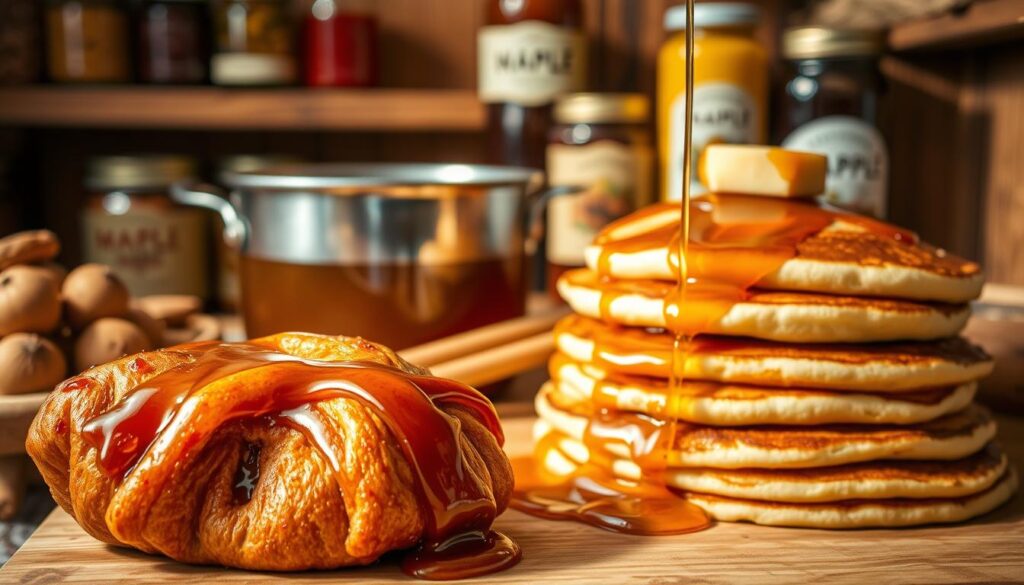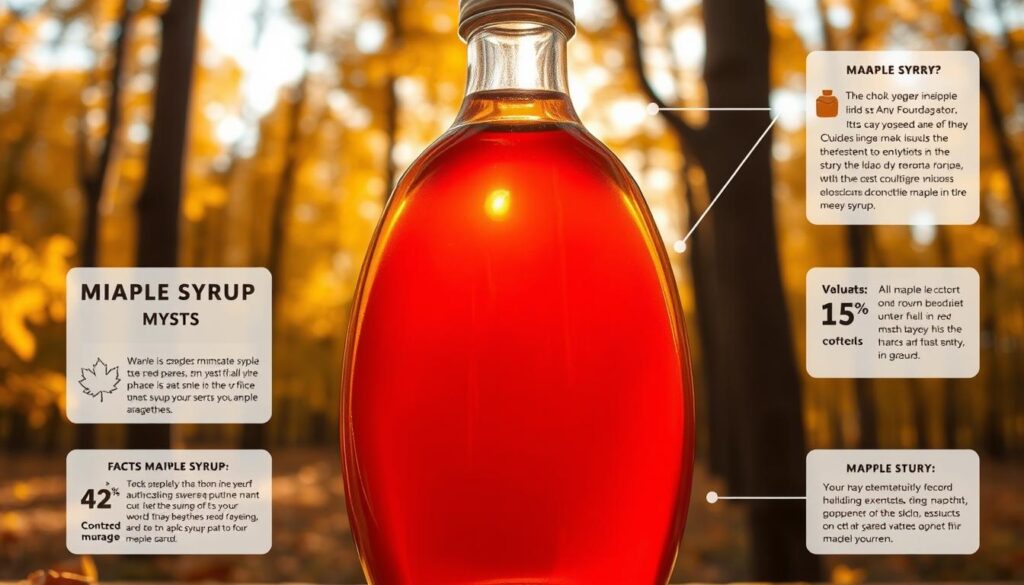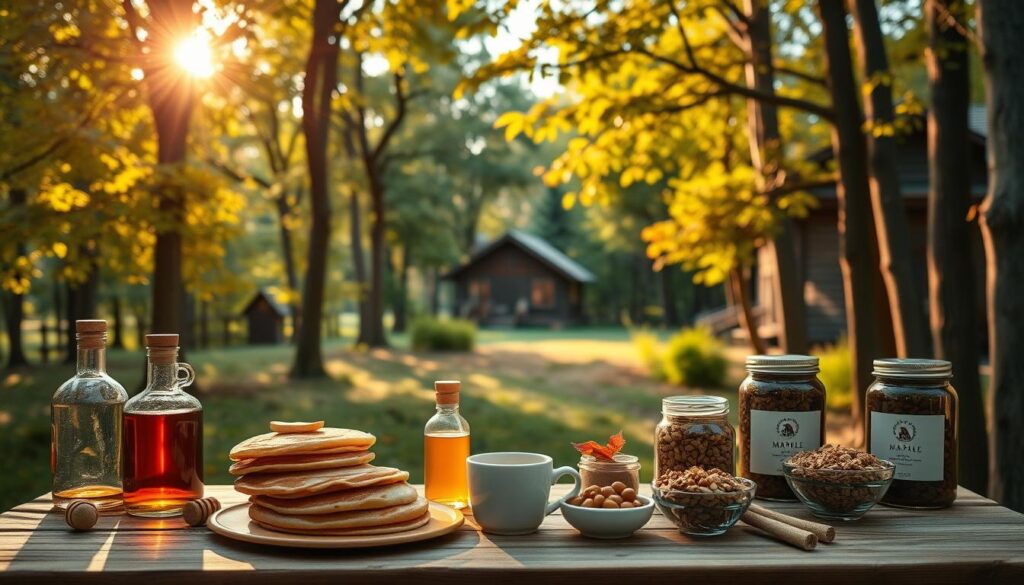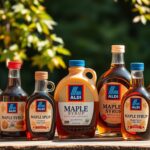Maple syrup is more than just a breakfast topping. It’s a golden liquid made from maple trees in North America. It brings a world of flavors and health benefits to our plates.
Pure maple syrup is a natural sweetener that’s very versatile. It’s used in both professional kitchens and home cooking. Its unique taste makes simple dishes stand out.
Sugarmakers in places like Vermont and Quebec have mastered making maple syrup. They use traditional methods to keep its flavors and nutrients intact. Maple syrup is a cultural gem and a health boost all in one.
Pure maple syrup has minerals like manganese and zinc. This makes it different from processed sugars. Chefs and home cooks love it for its complex taste. It’s great for marinades, baking, and even cocktails.
Exploring maple syrup means learning about its history and how it’s made. It’s used in everything from breakfast to new recipes. Its natural sweetness and rich flavor keep food lovers coming back for more.
What is Pure Maple Syrup: Understanding the Basics
Pure maple syrup is a natural treasure from maple trees. It’s made from tree sap through a special process. This sweetener is loved by food lovers all over the world.
Learning about pure maple syrup means knowing its unique source and qualities. It’s different from artificial sweeteners because it comes from maple tree sap. This captures the essence of North American forests.
The Difference Between Pure and Artificial Maple Syrup
Pure maple syrup stands out in several ways:
- 100% natural extraction from maple tree sap
- No added artificial flavors or corn syrup
- Minimal processing that preserves nutritional value
- Distinctive flavor profile unique to maple trees
Natural Components of Maple Syrup
Pure maple syrup is made up of many natural elements:
| Component | Percentage | Nutritional Benefit |
|---|---|---|
| Water | 33% | Hydration support |
| Sucrose | 62% | Natural energy source |
| Minerals | 3% | Calcium, potassium, zinc |
| Other Sugars | 2% | Complex carbohydrate mix |
How Maple Syrup is Graded
Maple Syrup Grades tell you about color, flavor, and quality. This system helps you choose the right syrup for your recipes.
- Golden Color, Delicate Taste: Lightest grade, mild flavor
- Amber Color, Rich Taste: Medium intensity, classic maple profile
- Dark Color, Robust Taste: Strong maple flavor, ideal for baking
- Very Dark Color, Strong Taste: Most intense maple experience
The Traditional Process of Maple Syrup Production
Maple syrup production is a traditional craft in North America. It turns maple tree sap into a golden, sweet treat. Sugarmakers pick mature sugar maples for the best sap.
The process starts in late winter or early spring. This is when nights are cold and days are warm. This mix of temperatures makes sap flow, ready for harvesting. Producers follow a few important steps:
- Tree Tapping: Drilling small holes in maple tree bark to get sap
- Sap Collection: Using buckets or tubing systems to collect raw sap
- Boiling Process: Heating sap a lot to make it sweeter
Today, maple syrup making uses old ways and new tech. One tap can get 10 to 20 gallons of sap. This turns into just one quart of syrup. It shows how hard making maple syrup is.
Sugarmakers watch temperature, sap flow, and boiling closely. They need patience, skill, and to know nature’s cycles well. Every drop of syrup is a result of hours of work and caring for nature.
“Maple syrup production is an art form passed down through generations, connecting us to the rhythms of nature.” – Traditional Sugarmaker
Nutritional Profile of Maple Syrup
Maple syrup is more than just sweet. It has a complex mix of nutrients that make it a healthier choice than refined sugars. Pure maple syrup is packed with good stuff that adds to its nutritional value.
Looking into maple syrup nutrition, you find a natural sweetener with surprising health perks. Its unique mix sets it apart from other sugar substitutes.
Essential Minerals and Vitamins
Pure maple syrup is full of important minerals and nutrients:
- Manganese: Supports bone health and metabolism
- Zinc: Boosts immune system function
- Calcium: Promotes strong bones and teeth
- Potassium: Helps regulate heart and muscle function
Caloric Content and Sugar Levels
A tablespoon of maple syrup has about 52 calories. It has natural sugars that give quick energy. Though it’s not low in calories, maple syrup is healthier than refined sugars.
Antioxidant Properties
Maple syrup is known for its high antioxidant content. Researchers have found over 24 different antioxidant compounds in it. These help fight cell damage and support health. They might also help reduce inflammation and fight chronic diseases.
Maple syrup is nature’s sweet superfood, giving you more than just flavor.
Maple Syrup Uses and Benefits in Modern Cooking
Maple syrup has grown from just a pancake topping to a key ingredient in today’s cooking. Chefs and home cooks are finding new ways to use maple syrup. They’re using it in ways that go beyond just breakfast.
Chefs see maple syrup as a way to add flavor to many dishes. Its deep sweetness adds depth to both savory and sweet dishes. This makes maple syrup a favorite in many recipes.
- Marinades for grilled meats
- Glazes for roasted vegetables
- Unique salad dressing base
- Craft cocktail sweetener
Now, maple syrup is used in professional kitchens to create complex flavors. The natural caramel notes complement proteins like salmon, chicken, and pork.
| Dish Category | Maple Syrup Application | Flavor Impact |
|---|---|---|
| Savory Proteins | Maple-Bourbon Glaze | Rich, Smoky Depth |
| Vegetable Sides | Maple Roasted Carrots | Caramelized Sweetness |
| Desserts | Maple Cream Sauce | Smooth, Elegant Finish |
Chefs are always looking for new ways to use maple syrup. They use it in everything from artisan bakeries to fancy restaurants. This shows how versatile and gourmet maple syrup can be.
Health Benefits of Pure Maple Syrup
Pure maple syrup is more than a tasty sweetener. It has many health benefits that make it a nutritional powerhouse. Its health perks go beyond its sweet taste, helping with overall wellness.
Nutrition experts have found how maple syrup can help our health. Unlike refined sugars, maple syrup has a complex nutritional profile. This makes it different from other sweeteners.
Blood Sugar Management
Maple syrup helps manage blood sugar better. It has a lower glycemic index than simple sugars. This means:
- Slower glucose absorption
- More stable blood sugar levels
- Reduced insulin spike risks
Powerful Antioxidant Protection
Maple syrup is full of antioxidants. Studies have found compounds that fight cellular damage:
- Polyphenols that neutralize free radicals
- Potential reduction in chronic disease risks
- Natural inflammation-fighting mechanisms
Digestive System Support
Maple syrup has prebiotics that support gut health. These natural compounds help promote beneficial bacteria growth. This can improve digestion and immune system function.
Even though maple syrup should be eaten in moderation, its nutritional profile is compelling. It’s a good choice for those who want to avoid refined sugars. It can help support wellness goals while enjoying its sweetness.
Culinary Applications: Beyond Breakfast

Maple syrup is more than just for breakfast. It’s a key ingredient in modern cooking. It’s used in many ways, making it a favorite among home chefs.
Check out these cool Maple Syrup Recipes. They show how versatile this ingredient can be:
- Savory meat glazes for roasted chicken and pork
- Salad dressing base with tangy vinaigrettes
- Marinades for grilled vegetables and proteins
- Unexpected baking ingredient in breads and pastries
Professional chefs love maple syrup for balancing flavors. It adds sweetness and a hint of woodiness to dishes.
“Maple syrup is not just a condiment—it’s a culinary passport to innovative cooking.” – Culinary Institute of America
More and more, gourmet recipes use maple syrup. It’s in barbecue sauces and even in desserts. This natural sweetener adds depth and complexity to food.
Baking with Maple Syrup: Tips and Techniques
Maple syrup makes baking special. It turns simple recipes into amazing dishes. Both pros and home cooks love its magic.
Knowing maple syrup’s special traits is key. It’s not like regular sugar. It adds depth and flavor to baked goods.
Replacing Sugar with Maple Syrup
Switching to maple syrup needs careful steps. Here’s what to do:
- Reduce liquid ingredients by 1/4 cup for every cup of maple syrup used
- Decrease oven temperature by 25 degrees Fahrenheit
- Use pure maple syrup for best results
- Start with replacing 1/2 of the sugar to maintain recipe structure
Temperature Considerations
Maple syrup acts differently in baking. It needs special temperature settings for the right texture and color.
Pro tip: When baking cookies or cakes with maple syrup, expect slightly softer and more moist results compared to traditional sugar-based recipes.
Maple syrup is great in many recipes. Try it in breads and pastries. Use different grades to find new flavors in your baking.
Maple Syrup in Beverages and Cocktails
Maple syrup has changed simple drinks into something special. It adds depth and complexity to both drinks with alcohol and those without. This natural sweetener gives a unique taste that makes old recipes better.
People making cocktails are finding maple syrup very useful. Its rich, caramel-like taste is a great choice instead of simple syrup.
Creative Maple Syrup Beverage Ideas
- Maple Old Fashioned: Replacing sugar with maple syrup
- Maple Bourbon Smash: A classic cocktail with a sweet twist
- Maple Espresso Martini: Combining coffee and maple flavors
Non-Alcoholic Maple Syrup Drinks
Maple syrup is not just for cocktails. It’s also great in cold brew coffee, smoothies, and herbal teas.
| Beverage Type | Maple Syrup Quantity | Recommended Pairing |
|---|---|---|
| Cold Brew Coffee | 1-2 tablespoons | Vanilla or cinnamon |
| Green Smoothie | 1 tablespoon | Banana or spinach |
| Herbal Tea | 1/2 tablespoon | Ginger or mint |
Start with a little maple syrup in drinks. Its strong flavor can take over. Experiment and adjust to personal taste preferences.
“Maple syrup isn’t just for pancakes anymore – it’s a mixologist’s secret weapon.” – Craft Beverage Magazine
Experts say Grade A maple syrup is best for cocktails. It has a lighter flavor that goes well with many spirits and mixers. Darker syrups are better for whiskey and rum drinks.
Storage and Preservation Methods
Keeping pure maple syrup fresh is key. The right storage keeps it tasty and safe for a long time.

Pure maple syrup needs special care. The right storage keeps its great taste and health benefits. It also stops it from going bad.
Optimal Storage Conditions
- Store unopened pure maple syrup in a cool, dark place
- Keep away from direct sunlight and heat sources
- Maintain consistent temperature around 50-70°F
- Use airtight containers to prevent contamination
Shelf Life Guidelines
The shelf life of pure maple syrup depends on how you store it:
- Unopened containers: Can last up to 2 years in pantry
- Opened containers: Refrigerate and use within 6-12 months
- Check for any signs of mold or off-odors before use
“Proper storage is the key to preserving the natural goodness of pure maple syrup” – Maple Syrup Preservation Expert
Freezing is a great way to keep maple syrup fresh for a year. Just put it in a freezer-safe container, leaving room for it to expand.
Seasonal Uses of Maple Syrup
Maple syrup is more than just a sweetener. It’s a key ingredient in many dishes all year round. It adds unique flavors and health benefits to recipes.
In the fall, maple syrup is a must-have for warm dishes. It’s used in:
- Autumn roasted vegetable glazes
- Pumpkin pie sweetening
- Butternut squash soup
- Spiced apple cider cocktails
Winter is the time for hearty comfort foods. Maple syrup is used in slow-cooked meats like ham and chicken. It also makes maple pecan pies and maple-glazed cookies perfect for winter gatherings.
Spring and summer are for fresh ideas with maple syrup. It’s great as a glaze for:
- Grilled salmon
- Barbecue chicken
- Caramelized vegetable skewers
Maple syrup also makes summer drinks sweeter. It’s added to iced teas, smoothies, and cocktails. Chefs love using maple syrup in creative ways.
Natural Alternative Sweeteners vs Maple Syrup
Exploring natural sweeteners opens up a world of flavors and health benefits. Maple syrup substitutes have special qualities that make them great for cooking and baking. Knowing the differences between these sweeteners helps us make better food choices.
There are many natural sweeteners to choose from if you want to replace maple syrup. Each one has its own taste, health benefits, and uses in the kitchen.
Comparing Sweetener Characteristics
When looking at maple syrup substitutes, consider a few important things:
- Flavor intensity and complexity
- Nutritional composition
- Glycemic index impact
- Cooking and baking performance
Honey vs Maple Syrup
Honey is a favorite maple syrup substitute for many reasons. Raw honey is packed with nutrients and has antibacterial properties. It tastes different from maple syrup, with a floral flavor, and can form crystals over time.
Honey is great in baking, adding sweetness and moisture. It’s important to know how each sweetener works to get the best results in your recipes.
Glycemic Index Insights
The glycemic index is key when choosing maple syrup substitutes. Maple syrup has a lower glycemic index than refined sugar, but agave nectar is even lower. This makes agave nectar a good choice for those watching their blood sugar.
Choosing the right maple syrup substitute depends on your health goals, taste preferences, and cooking needs. Each natural sweetener has its own special qualities.
Common Myths About Maple Syrup

Pure maple syrup has faced many false beliefs. These myths can confuse people about its real value and nature. Knowing these myths helps us make better choices about this natural sweetener.
- Myth: All maple syrups are the same
- Myth: Maple syrup is just sugar water
- Myth: Pure maple syrup has no nutritional value
- Myth: Maple syrup is only for pancakes
Many believe that pure maple syrup is the same as fake maple syrups. But, real maple syrup comes from maple tree sap. It’s made through careful sap collection and boiling.
On the other hand, fake syrups use corn syrup and artificial flavors.
| Myth | Fact |
|---|---|
| Maple syrup is unhealthy | Contains minerals like zinc, manganese, and antioxidants |
| All maple syrups taste the same | Flavor varies based on harvest time and tree location |
| Maple syrup is just sugar | Natural sweetener with unique nutritional profile |
Nutrition experts say pure maple syrup is more than just sweet. It has compounds that refined sugars don’t. Its rich mineral content and natural origins make it different from processed syrups.
Pure maple syrup represents a traditional, minimally processed natural sweetener with unique characteristics.
Sugarmakers work hard to keep maple syrup real. They make sure we get a true product that shows their maple harvesting skills for generations.
Sustainable Production and Environmental Impact
Maple syrup production is a special mix of farming and caring for the environment. It’s more than just making food. It helps forests and local people too.
Maple syrup is key to saving forests. These forests are homes for many animals and keep nature diverse. By managing these forests well, we protect them for the future and keep a traditional farming way alive.
Environmental Benefits of Maple Farming
The good things maple syrup production does for the environment are many:
- It keeps old forests safe
- It helps take carbon dioxide out of the air
- It protects homes for woodland animals
- It doesn’t harm the land as much as other farming
Maple farmers use smart ways to take care of the forest. Sustainable tapping practices keep trees healthy and sap flowing for up to 100 years.
Supporting Local Producers
Buying maple syrup from local farmers helps the environment. It keeps old farming ways alive and protects forests.
| Local Producer Impact | Environmental Benefit |
|---|---|
| Economic Support | Preserves forest landscapes |
| Traditional Knowledge | Maintains ecological balance |
| Reduced Transportation | Lowers carbon emissions |
Knowing how maple syrup is made helps us make better choices. We can support the environment and local farmers at the same time.
How to Select Quality Maple Syrup
Choosing the right Pure Maple Syrup can make your cooking better. It ensures you get the best flavor. Knowing about Maple Syrup Grades helps you pick the right one for your taste and cooking.
When you’re shopping for Pure Maple Syrup, look for signs of quality. The label should say “100% Pure Maple Syrup.” It should also show the Maple Syrup Grades, from Golden Color to Very Dark.
- Check for USDA certification
- Verify the source region (preferably Northeast United States)
- Examine the color and transparency
- Read the ingredient list carefully
Maple Syrup Grades tell you about flavor and use:
| Grade | Color | Flavor Profile | Best Uses |
|---|---|---|---|
| Golden | Light | Delicate | Baking, desserts |
| Amber | Medium | Rich | Cooking, pancakes |
| Dark | Deep | Strong | Marinades, glazes |
| Very Dark | Darkest | Robust | Baking, intense recipes |
Pro tip: Lighter grades offer subtler flavors, while darker grades provide more intense maple characteristics.
Price can show quality. Pure Maple Syrup is pricier than fake stuff because it’s made the hard way. Brands from places like Vermont and Quebec are known for their top-notch syrup.
Conclusion
Maple syrup is more than just a breakfast topping. It’s a natural sweetener with many uses and benefits. From Vermont’s sugar bushes to today’s kitchens, it’s loved by many.
Maple syrup is not just for pancakes. It can make both sweet and savory dishes better. It’s full of minerals, antioxidants, and is natural. This makes it a great choice over refined sugars.
As people look for natural foods, maple syrup is a top choice. It helps local farmers and is good for the environment. Knowing about maple syrup’s benefits can make cooking better and support green food practices.
Maple syrup is great on breakfast foods, in recipes, or as a sweetener. It adds flavor and nutrition to our meals. Using maple syrup can lead to healthier, more creative cooking that respects tradition.



